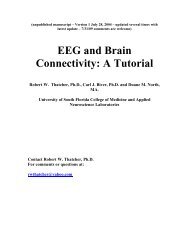USE3 Physiolab Software Guide - J&J Engineering Biofeedback ...
USE3 Physiolab Software Guide - J&J Engineering Biofeedback ...
USE3 Physiolab Software Guide - J&J Engineering Biofeedback ...
You also want an ePaper? Increase the reach of your titles
YUMPU automatically turns print PDFs into web optimized ePapers that Google loves.
<strong>Physiolab</strong> <strong>Software</strong> <strong>Guide</strong> 46<br />
EMG Displays<br />
A “W” specified before a screen name in the Select Screen Bar indicates that a<br />
wide bandpass filter (20-400Hz) has been applied to EMG signals displayed in<br />
that screen. The wide bandpass filter eliminates artifact frequencies outside of<br />
the EMG range. If no “W” appears before a screen name, an additional narrow<br />
band filter (100-400 Hz) has been applied to EMG displays on that screen. This<br />
narrow band filter eliminates heart artifact from the EMG signal. Within the<br />
display, narrow band EMG signals will be labeled with an “N”. For example,<br />
FFT_EMG A N or EMG-B RMS N. The A or B refers to the input receiving the<br />
EMG signal. Wide band EMG signals are labeled within displays with a “W” as<br />
follows: EMG-B W or EMG-A RMS W.<br />
The signal is then passed through a 50 or 60 Hz notch filter to eliminate power<br />
line artifact. (For more information please see “Eliminating Electrical Line<br />
Frequency Noise” in the “Configuring the <strong>Software</strong>” section.<br />
Unless the screen is labeled “Raw” or “FFT” it contains EMG RMS (Root Mean<br />
Square) signals. Most EMG biofeedback screens display EMG RMS signals.<br />
EMG RMS screens are defaulted to AutoOffset ON so that the Signal Up/Down<br />
buttons are disabled. This is because evaluating the signal in relation to zero is<br />
essential to EMG RMS measurements. Moving the signal up so that the zero is<br />
no longer visible on the scale would not be desirable for this display.<br />
W-EMG Displays<br />
The following display descriptions apply to both wide band and narrow band<br />
EMG displays. The screen choices are identical, but a filter to eliminate heart<br />
artifact has been applied to the signals in the narrow band screens. Wide band<br />
displays show a greater degree of muscle activity so normally you will want to<br />
use wide band displays unless the site you are monitoring is contaminated by<br />
heart muscle artifact. Narrow electrode muscle placement and placement far<br />
from the heart will have less artifact than wide placement and electrode sites<br />
close to the heart. You can determine if heart artifact is a problem if there is an<br />
observable R-wave point in a raw EMG display and/or a rhythmic pulsing in the<br />
100-400 Hz range of an EMG FFT display. If heart artifact is present, use the<br />
screens without the “W” designation (the narrow bandpass screens).<br />
Single Signal Displays<br />
The following EMG displays contain only one signal per line graph space:<br />
Raw EMG<br />
A line graph display with vertical microvolt scale and horizontal time scale, which<br />
provides a very fast response display of raw EMG activity. Because this display<br />
responds very fast to very small movements, it is useful for EMG activity that is
















